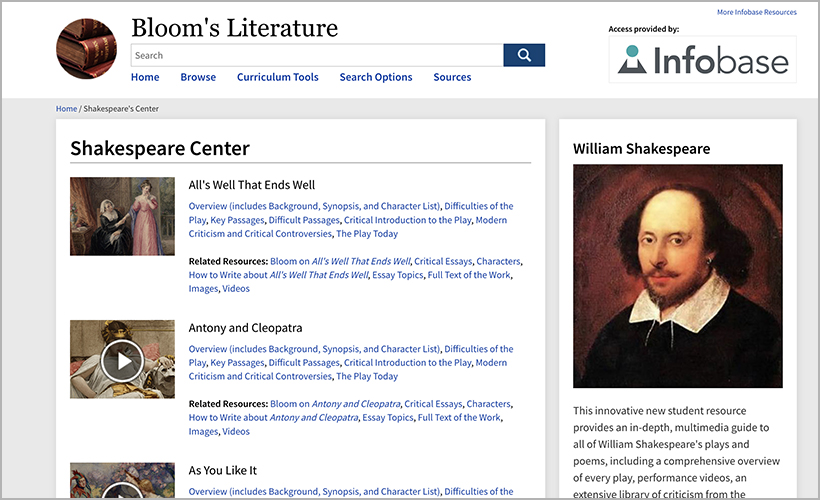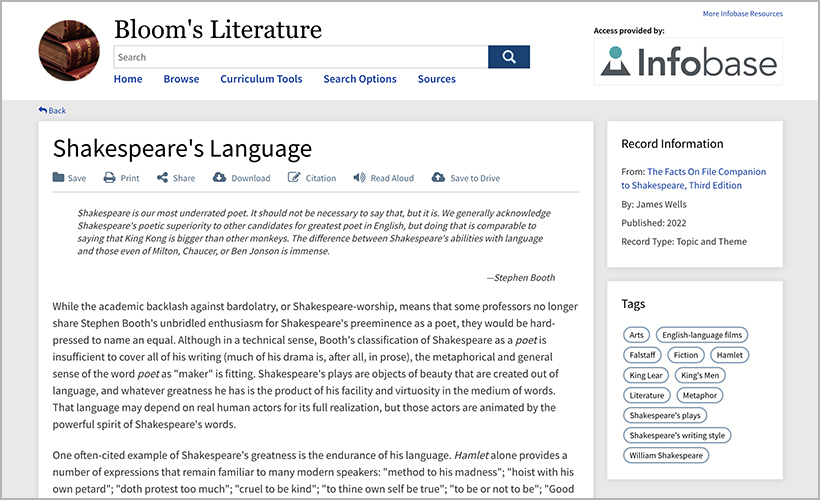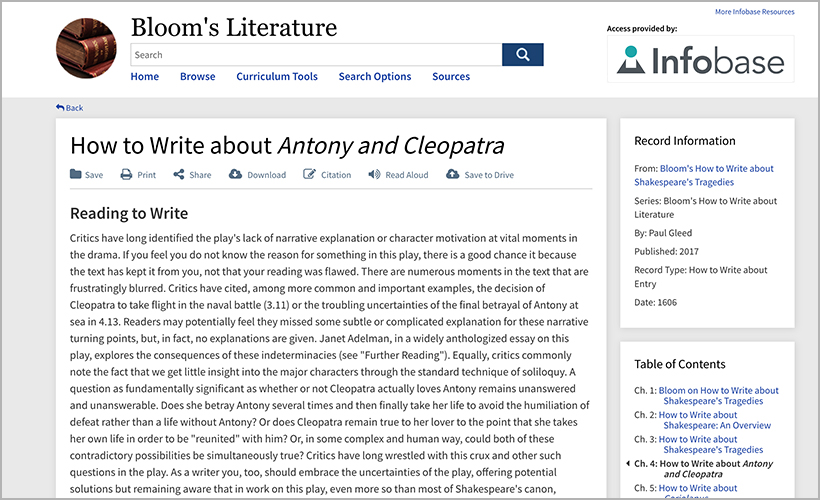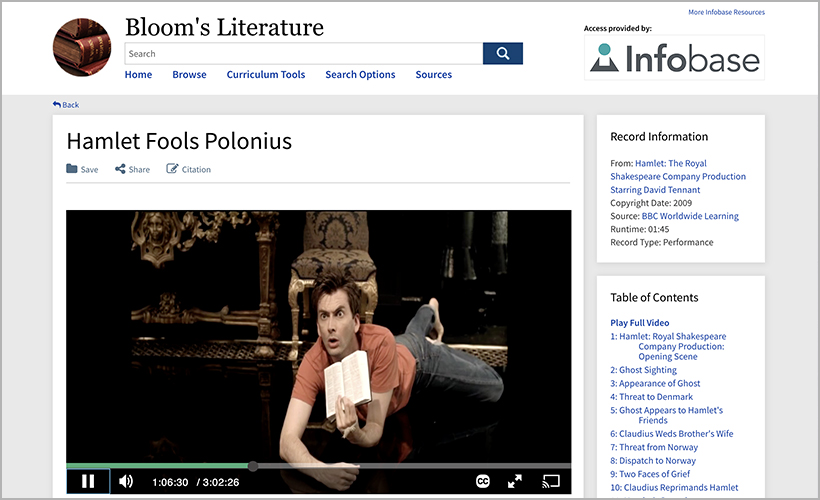Celebrate Shakespeare with Bloom’s Literature

William Shakespeare’s impact on literature is almost impossible to measure. He was responsible for introducing somewhere between 1,500 to 3,000 words to the English language, and people are still making adaptations of his works 400 years after they were written. Yet, while the Bard is a staple in most English literature classrooms, it can be tricky to avoid having some students say, like King Lear, “Never, never, never, never, never!” when one of his works is assigned.
Luckily, students don’t have to tackle Shakespeare alone. Bloom’s Literature, Infobase’s award-winning literature database, features a comprehensive section devoted to his works. Bloom’s Literature’s Shakespeare Center houses in one convenient location a treasure trove of content on all things Shakespeare. Every play is covered in depth, along with the sonnets and longer poems. Students and educators can find critical articles by noted scholars, the full text of all his plays, character studies, overviews and synopses, analysis of key passages, thought-provoking essay topics and discussion questions, images and illustrations, discussions of each play’s difficulties, “How to Write About” articles, full-length video performances, background on Shakespeare, and so much more.

Here are some ideas for how you can use the resources you’ll find in Bloom’s Literature’s Shakespeare Center in classes, assignments, and more—and have a little fun while doing it.
Act Out a Scene from a Play
Divide your students into groups and have them pick a favorite scene from one of Shakespeare’s plays to perform. Bloom’s Literature’s Shakespeare Center features the full text of all of his plays that students can use to find the scene they’re looking for. If students are having a tough time with some of the passages from that scene, encourage them to check out the “Difficult Passages” article to help clarify challenging sections.
Write Like Shakespeare
Do your students “protest too much”? As an educator, do you sometimes have to be “cruel only to be kind”? These phrases come from Shakespeare, so why not challenge your students to come up with a turn of phrase in the style of Shakespeare? Have each student come up with a Shakespearean phrase and have the other students vote on their favorite one; for ideas on what to write and to get a sense of how to phrase it, Bloom’s Literature’s Shakespeare Center features an article on Shakespeare’s language that breaks down what makes his writing so unique. From there, you could have students come up with a Shakespeare-style speech or write a story that uses the new phrase.

Writing Sonnets
In addition to his plays, Bloom’s Literature’s Shakespeare Center also features all of his sonnets. Use them to inspire your students to write their own sonnets in the style of Shakespeare, with iambic pentameter and the “abab cdcd efef gg” rhyming pattern. If sonnets sound too formal, consider having students do a Shakespeare-inspired rap instead.
Character Connection
Writers have been imitating Shakespeare’s characters for hundreds of years. Ask students to select a character from a play and find a character who closely resembles this character in another work. Make the assignment more appealing by letting them use TV shows, movie characters, superheroes, comic books, etc. Bloom’s Literature’s Shakespeare Center includes character lists for each play, plus the “How to Write about” sections provide sample topics about characters to provoke critical thinking.

Watch a Film Adaptation of a Shakespearean Play
Shakespeare’s written word can be a little hard for modern audiences to follow, but seeing one of his plays in action can help clarify what’s going on. Bloom’s Literature features more than 1,300 full-length videos, including performances of great literary works to engage students and make the literature come to life. Closed-captioning and interactive transcripts make it easy for students to follow along. The videos are conveniently segmented so it’s easy to find and use specific portions, or the whole performance can be shown in its entirety. Have students watch one of the many film adaptations of Shakespeare’s plays you can find in Bloom’s Literature’s Shakespeare Center.
The performances you can find include:
- The Royal Shakespeare Company’s adaptation of Hamlet starring David Tennant and Patrick Stewart
- Sir Laurence Olivier’s As You Like It and Henry V
- The classic film adaptation of Julius Caesar with Sir John Gielgud and Charlton Heston
- Akira Kurosawa’s Throne of Blood, which sets Macbeth in medieval Japan
- Othello: The Shakespeare Series starring William Marshall
- The Royal National Theatre’s production of King Lear starring Ian Holm
- Antony and Cleopatra: The Shakespeare Series starring Timothy Dalton
- And more!

Sources:
Wells, James. 2022. “Shakespeare’s Language.” The Facts On File Companion to Shakespeare, Third Edition. Facts On File. online.infobase.com/Auth/Index?aid=10835&itemid=WE54&articleId=482200.
Hewson, Claire. “8 Ways to Celebrate Shakespeare Day.” Tutor My Kids. March 29, 2021. https://tutormykids.co.uk/2021/03/29/10-ways-to-celebrate-shakespeare-day/.
Mascenik, Mila. “5 Ways to Celebrate Shakespeare’s Birthday.” Jane Austen Summer Program. April 21, 2022. https://www.janeaustensummer.org/post/5-ways-to-celebrate-shakespeare-s-birthday.
